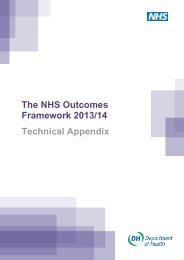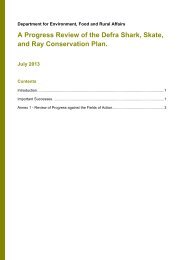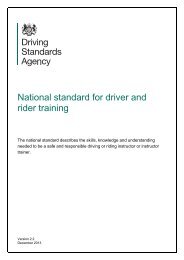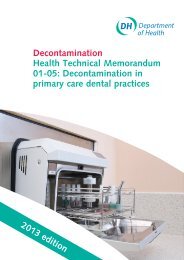Annual Report & Accounts 2007-2008 - Historic Scotland
Annual Report & Accounts 2007-2008 - Historic Scotland
Annual Report & Accounts 2007-2008 - Historic Scotland
You also want an ePaper? Increase the reach of your titles
YUMPU automatically turns print PDFs into web optimized ePapers that Google loves.
Civil Service Pensions<br />
Pension benefits are provided through the Civil Service Pension (CSP) arrangements. From<br />
30 July <strong>2007</strong>, civil servants may be in one of four defined benefit schemes; either a ‘final<br />
salary’ scheme (classic, premium or classic plus); or a ‘whole career’ scheme (nuvos).<br />
These statutory arrangements are unfunded with the cost of benefits met by monies<br />
voted by Parliament each year. Pensions payable under classic, premium, classic plus<br />
and nuvos are increased annually in line with changes in the Retail Price Index (RPI).<br />
Members joining from October 2002 may opt for either the appropriate defined benefit<br />
arrangement or a good quality ‘money purchase’ stakeholder pension with a significant<br />
employer contribution (partnership pension account).<br />
Employee contributions are set at the rate of 1.5% of pensionable earnings for classic<br />
and 3.5% for classic, premium, classic plus and nuvos. Benefits in classic accrue at the<br />
rate of 1/80th of final pensionable earnings for each year of service. In addition, a lump<br />
sum equivalent to three years’ pension is payable on retirement. For premium, benefits<br />
accrue at the rate of 1/60th of final pensionable earnings for each year of service. Unlike<br />
classic, there is no automatic lump sum. Classic plus is essentially a hybrid with benefits<br />
in respect of service before 1 October 2002 calculated broadly as per classic and benefits<br />
for service from October 2002 calculated as in premium. In nuvos a member builds up a<br />
pension based on his pensionable earnings during their period of scheme membership. At<br />
the end of the scheme year (31 March) the member’s earned pension account is credited<br />
with 2.3% of their pensionable earnings in that scheme year and the accrued pension is<br />
uprated in line with RPI. In all cases members may opt to give up (commute) pension for<br />
lump sum up to the limits set by the Finance Act 2004.<br />
The partnership pension account is a stakeholder pension arrangement. The employer<br />
makes a basic contribution of between 3% and 12.5% (depending on the age of the<br />
member) into a stakeholder pension product chosen by the employee from a panel of<br />
three providers. The employee does not have to contribute but where they do make<br />
contributions, the employer will match these up to a limit of 3% of pensionable salary (in<br />
addition to the employer’s basic contribution). Employers also contribute a further 0.8%<br />
of pensionable salary to cover the cost of centrally-provided risk benefit cover (death in<br />
service and ill health retirement).<br />
The accrued pension quoted is the pension the member is entitled to receive when they<br />
reach pension age, or immediately on ceasing to be an active member of the scheme<br />
if they are already at or over pension age. Pension age is 60 for members of classic,<br />
premium and classic plus and 65 for members of nuvos.<br />
Further details about the Civil Service pension arrangements can be found at the website<br />
www.civilservice-pensions.gov.uk<br />
REPORT & ACCOUNTS 45

















